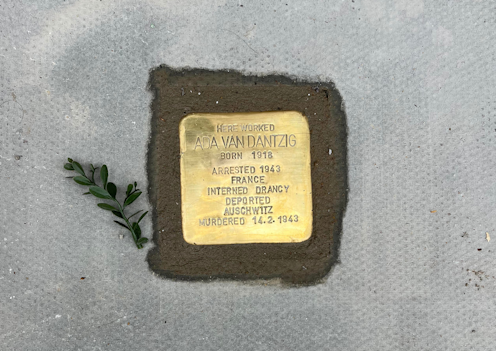
The world’s largest memorial is about to get a little bigger, as it comes to Britain for the first time. It began life in 1992, when German artist Gunter Demnig laid the first “Stolperstein” – or stumbling stone – in Cologne, Germany. Since then, more than 75,000 memorials, each the size of a square cobble stone, have been installed in more than 20 countries.
Britain is now to be added to that growing list as a 10 x 10cm brass plate is unveiled in Golden Square, in central London. On it will be engraved the name of Ada van Dantzig, a Dutch Jewish woman who worked in London but was murdered in Auschwitz in 1943.
The presence of a memorial to Dantzig, hundreds of miles from the infamous death camp built in Nazi-occupied Poland, may seem strange. But it is key to Demnig’s vision of what this decentralised memorial might do. Rather than sending us to one of the former camps, replete with their large central stone and concrete memorials, Demnig decided to bring the memorials to us by embedding the stumbling stones in the ordinary streets of more than 1,000 towns and cities across Europe and beyond.
Expanding the landscape of the Holocaust
Speaking ahead of the laying of Dantzig’s stone, Demnig stressed:
A person is only forgotten when his or her name is forgotten. With this Stolperstein, Ada van Dantzig’s name, inscribed into the urban landscape of Soho, will be remembered.
Locations, as with this spot in Soho, were chosen because these were the last known residences or workplaces of those murdered.
In many cases, Stolpersteine mark the homes where Jews were deported from. Others mark the last place from which Jews fled. This is the case for Dantzig, who came to London to learn the craft of painting conservation in the studio of the preeminent conservator Helmut Ruhemann, which was located in Golden Square. She left London to help her family escape to neutral Switzerland. However, the escape plan failed and the whole family, apart from one brother, was deported to Auschwitz. Dantzig was killed on 14 February 1943. She was 24 years old.
By marking the places that Jews were taken from, rather than only the places where they were taken, Demnig extends the landscape of the Holocaust from a handful of death camps, or hundreds of ghettos, back to thousands of addresses across Europe where Jews were arrested or fled. It is as if he is saying that the genocide started here – when people were forced to leave their homes.
Stolpersteine reveal the continental reach and scale of the Holocaust stone by stone. But they also bring this event so much closer to home and make it one that intrudes into our everyday lives.
How to remember
How to remember war and genocide emerged as pressing concerns in the 20th century. One set of questions – where to remember – revolved around whether to remember centrally at one national memorial – often in a country’s capital – or locally at thousands of decentralised memorials. Travelling around France or Britain, it is clear that in the aftermath of the first world war, both national and local memorials were chosen to mark what was known as the Great War.
But another set of questions – how to remember – revolved around what memorials are meant to do – to console or to provoke. This became a matter of intense debate in Germany in the 1980s and 1990s, with the development of what Holocaust and memory studies scholar James Young calls “counter-monuments”, which are monuments that take a new form to ensure that they don’t glorify the past, but instead encourage visitors to face the history head on. In the aftermath of the Holocaust, a new generation of artists asked what new forms memorials to the victims of National Socialism might take.
Demnig’s work can be seen as a response to both the question of where and how to remember. Stolpersteine are a supremely decentralised series of counter monuments. Rather than limiting the memory of the Holocaust to one site that we choose, or don’t choose, to visit, perhaps on a portentous anniversary, Stolpersteine literally cause us to stumble over the memory of this event as we go about our day to day lives time and time again.
While never intended to trip up the passer by, these stumbling stones are intended to halt us in their tracks and call us to imaginatively connect the front door before us with other doors – the gates of ghettos and gas chambers – by drawing attention to the beginnings of thousands of Holocaust journeys that were, for Jews like Ada van Dantzig, to be their final journey.
Tim Cole receives funding from UKRI and the Toni Schiff Foundation. He is the Chair of the 'We are Bristol History Commission' set up by the Mayor of Bristol in the aftermath of the toppling of the Colston Statue.
This article was originally published on The Conversation. Read the original article.







